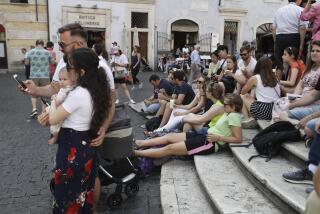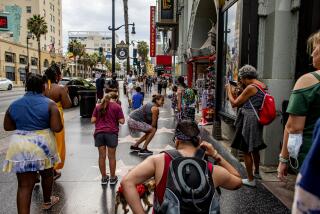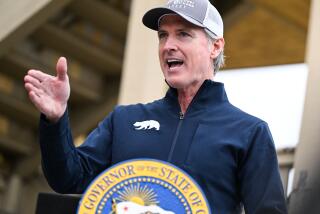Column: Trumpâs travel ban is already helping to crater U.S. tourism â and it will cost you

President Trumpâs anti-immigrant rhetoric and comments about a âtravel banâ is sometimes taken as just talk, with no follow-through. But itâs having a detectable effect on an important sector of the U.S. economyâtourism.
The United States has lost measurable market share as a travel destination from late 2016 through early this year. Thatâs according to the travel analysis firm Foursquare, which tracks foot traffic globally through apps on millions of smartphones and websites people use to navigate and check in at hotels, department stores, malls, theme parks and other leisure destinations, and convention centers and other business venues.
According to a recent blog post by its CEO Jeff Glueck, U.S. tourism share fell by 6% year-over-year starting in October, and continued to decrease through March, when it dropped all the way to 16%.
Some of the...policies have been focused on countries within the Middle East and Latin America. Weâre seeing a greater impact in travel from those nations.
— Jeff Glueck, Foursquare
The average decline over that period is 11%, with âno sign of recovery in the data,â Glueck wrote. The biggest beneficiary seems to be Asia, which has picked up leisure business at the expense of the U.S.
Particularly hard hit, the firm says, are California destinations such as San Diego, Los Angeles and San Francisco. San Diego saw a decline in leisure foot traffic share of 9.9% from the last quarter of 2016 through the first quarter of 2017, compared to a year earlier; the overall decline in the three big destination cities was 3.6%. Foursquare says thatâs notable because those cities had seen surges in foot traffic in the first nine months of last year.
Foursquare doesnât collect information that might explain why these shifts are taking place, but the patterns are suggestive. Sarah Spagnolo, the firmâs editor-at-large, says that San Diego is an especially popular destination for Mexican tourists. They may well be discouraged by Trumpâs oft-expressed hostility to immigration from that country.
The firm also noticed that residents of the Middle East, and Central and South America are traveling less to the U.S. more than residents of Asia, Europe and elsewhere. âSome of the current administrationâs most controversial policies have been focused on countries within the Middle East and Latin America,â Glueck observed. âWeâre seeing a greater impact in travel from these nations.â
Business travel to the U.S. is still showing positive growth of about 3% compared to a year ago, Spagnolo says. But itâs lagging the rest of the world, where business foot traffic has been up 10%.
Trump issued his original travel ban by executive order on Jan. 27, one week after taking office. The order barred entry for 90 days for any visitors from seven countries: Iraq, Iran, Libya, Somalia, Sudan, Syria and Yemen.
After several federal judges and appeals courts suspended parts or all of the order, a new one was issued that made modest changes and removed Iraq from the list. The administration has appealed the federal judgesâ rulings to the Supreme Court.
Foursquareâs findings parallel those of other tourism analysts. Travel data firm ForwardKeys found that in the immediate aftermath of the inauguration and the initial travel ban, overall flight bookings to the U.S. were down 6.5% from a year earlier.
The largest decline was in travel from the Middle East, down 37.5%. Bookings from Saudi Arabia were down 60%, though ForwardKeys said that at least part of the decline may have been due to a school break, which fell at a different time a year ago. Travel from Western Europe was off by 13.6%.
ForwardKeys also found that a decline in flight reservations for three months ahead got steeper in the weeks after the inauguration, with the sharpest drops occurring in bookings from the Middle East, especially the seven countries named in Trumpâs initial ban (Iraq, Syria, Iran, Libya, Somalia, Sudan and Yemen).
The tourism decline could have a measurable impact on the economy. At $1.7 trillion in direct and indirect spending as of the end of 2016, travel and tourism accounts for roughly 10% of gross domestic product, according to the Bureau of Economic Analysis. The Bureau of Labor Statistics places the leisure and hospitality workforce at about 16 million. Thatâs 10% of the civilian labor force.
Travel companies such as airlines have been cautious about the effect of Trumpâs words and policies, typically stating that they havenât seen much evidence of a change in bookings. But reports of travelersâ concerns about hassles they face traveling to the U.S. or entering the country upon arrival are common.
And travel analysts generally have been expressing concerns about the confusion produced by administration decisions, including heightened scrutiny of visa applicants and seemingly arbitrary refusals of entry,
A Toronto school district, for instance, said earlier this year that it was canceling annual field trips to the U.S. out of fears that some of the students might be refused entry. Trumpâs rhetoric âhas damaged the U.S. brand as a destination,â Adam Sacks, president of Tourism Economics, told CNN. That could have effects that linger far longer than the administration does.
Keep up to date with Michael Hiltzik. Follow @hiltzikm on Twitter, see his Facebook page, or email [email protected].
Return to Michael Hiltzikâs blog.
MORE FROM MICHAEL HILTZIK
Trumpâs rollback of birth control rights will run into a legal buzzsaw
Desperate to keep its Obamacare exchange open, New York plays hardball with health insurers
More to Read
Inside the business of entertainment
The Wide Shot brings you news, analysis and insights on everything from streaming wars to production â and what it all means for the future.
You may occasionally receive promotional content from the Los Angeles Times.











